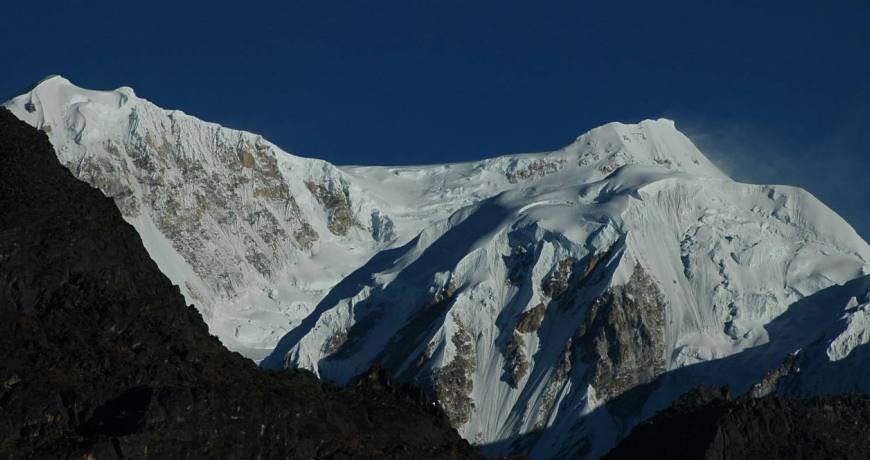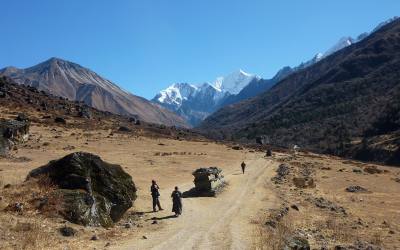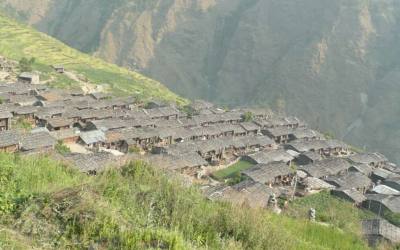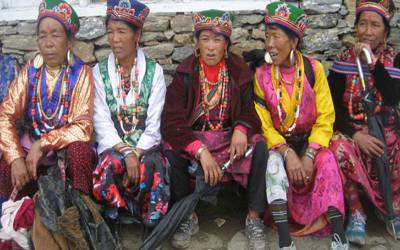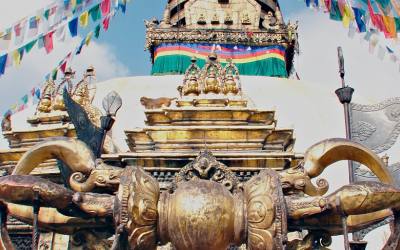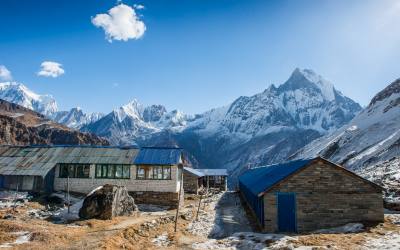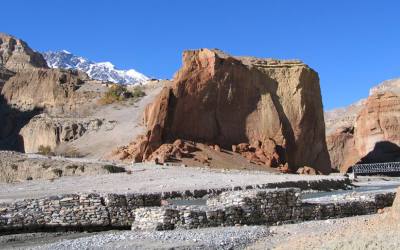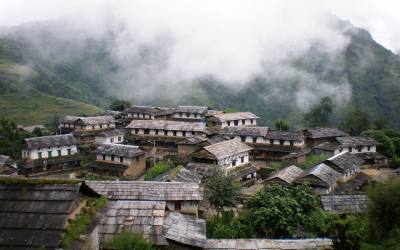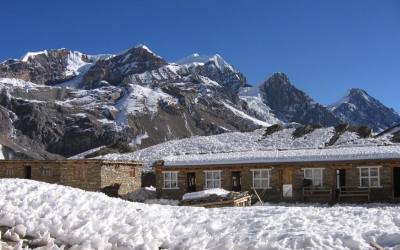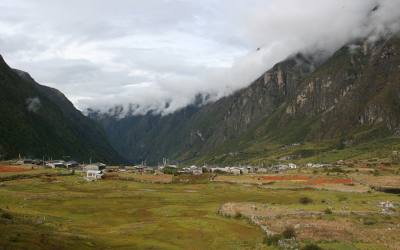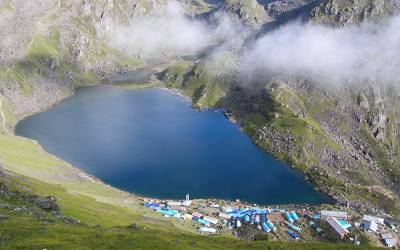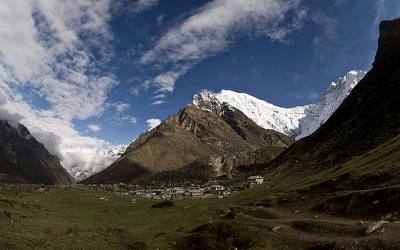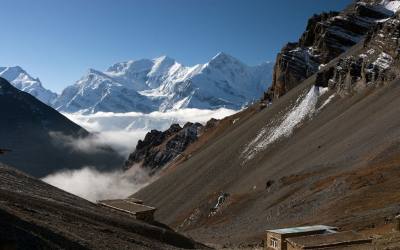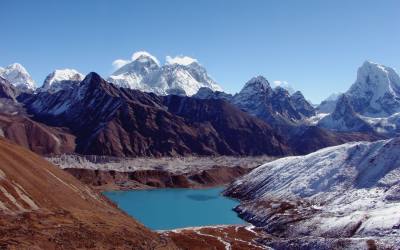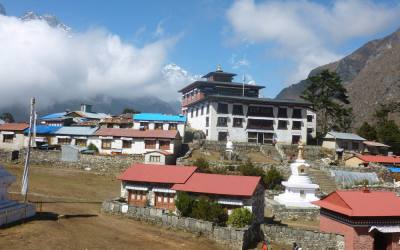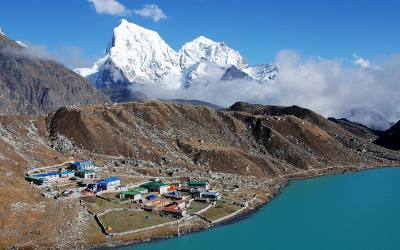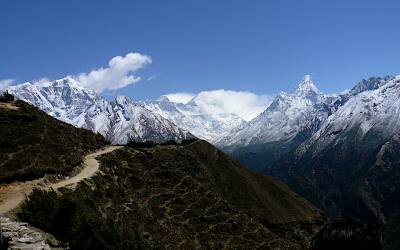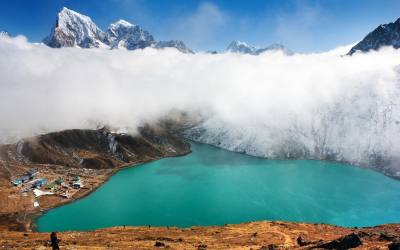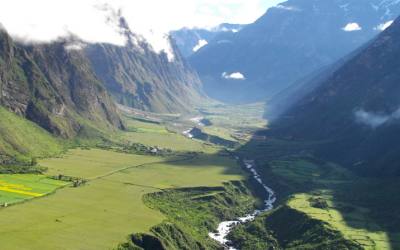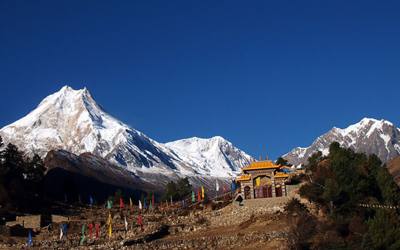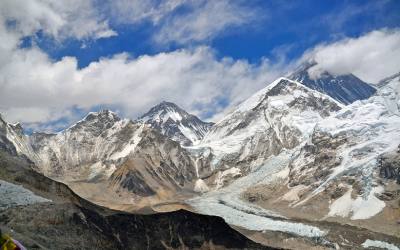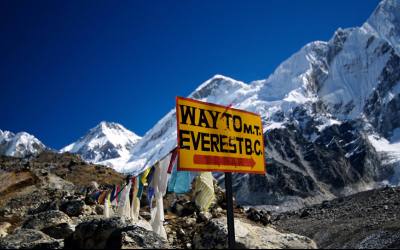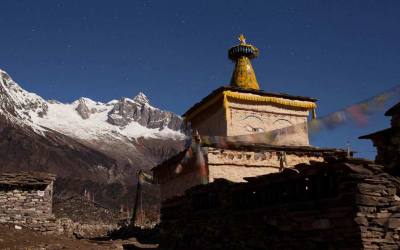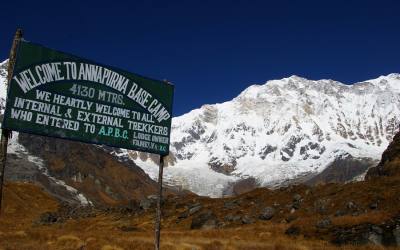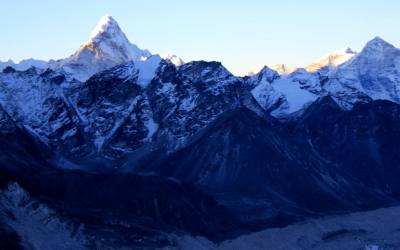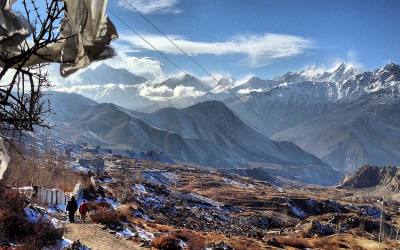Kangchenjunga North and South
Nepal’s second highest peak and the third in the world. The kangchenjunga is located in the north-eastern corner in Taplejung district. Its main ridges which run from N.N.E. to S.S.W. from a natural boundary between these two state, as well as watershed to several important rivers. Twelve miles north of kangchenjunga is the Tibetan frontier. This runs along the main watershed of the Himalayas,which separates the arid plateau of Tibet on the north from the more fertile and rain washed country to the south. On the watershed, however there are not elevations to rival kangchenjunga, so the the mountain and its satellite peaks form a huge mountain massif pushed southwards from the main Himalayan range.
Of independent mountains, there is no finer example than kangchenjunga. It is a mountain great enough to posses its own glaciers radiating from its several summits and though surrounded by many vassal peaks, which add their quota to the ice rivers radiating from the main massif, the glaciers which flow far down to the fringe of the tropical forests cloaking the lower valley are the undisputed possession of the monarch of the the world’s first half dozen peak. Kanchenjunga is the only one that displays its glories to the world at large. Only those who can afford the time and expenses necessary to penetrate the remote fastness from which they spring can view the glories of Everest on the karakorams but kangchenjunga is to be seen easily from anyone of the lower foot hills.
Kangchenjunga is large enough not only to make its own weather, but to catch the full force of ready-made weather in addition. Only low foot-hills separate it from the plain of Bengal and these are not high enough to afford its protection from the sought-west monsoon. The result of this is an annual precipitation of snow that is probably greater than that of any other peak in the Himalayas. Because of this kangchenjunga boasts some of the most magnificent snow and ice scenery in the world.
Kanchenjunga not only breaks the force of the monsoon, but protects the main watershed to the north from its onslaught to a great extent. The result of this is an extra ordinary variation of scenery and climate with in a small area. The dry, almost dusty hill at the head of the Lhonak valley, The Dodang Nyima range and the plateaux of Tibet beyond are in striking contrast to the valley radiating southwards from kangchenjunga, for here is a dry reddish brown country with a snow level appreciably higher and glaciers considerably smaller than those of kangchenjunga and its immediate neighbours.
There is probably no other mountain where the mountaineer is exposed to greater dangers than he is on kangchenjunga, for not only has the ice avalanches to contend with, but incertain weather as well weather in calculable both in cause and effect.
With such a mountain before their eyes, it is perhaps small wonder that the peoples in habiting the valleys round kanchenjung have become impregnated with the grandeur and mystery of the great mountain. To them its five summits are the FIVE treasures of the snow and on them rests the throne of an all powerful god. Their prosperity and even their lives depend on the good humour of this god, for He is able to blast their crops with his storms or destroy their village with his floods and avalanches.
Roughly speaking, there are four main lines of approach of kangchenjunga, up the valley of the Tamor river in Nepal, passing Ghunsa and Kangbachen, up the Yalung valley in Nepal, up the valley of the Teesta river in sikkim, and up the Talung valley also in sikkim. Between the Yalung and Talung valleys there is also the Rangit river, which has its sources in the glaciers of Kabru, 2400 feet, one of kangchenjunga’s out post peaks to the south.
In this mountain area there are eleven peaks over 7000 m high are has many beautiful glaciers, probably the longest in the world.
The covering of kangchenjunga area is 55% of the Taplejung district area and 1.40% of the total area of country. Its 65% area is covered by high Himalayas and mountain rocks and ice and remaining 55% is covered by forests, shrub-land, grass-land and agricultural-land .the climate of this area varies from subtropical monsoon at lower elevation to alpine. The highest rain-fall is recorded in the month of August 400m.m. lowest in December.
The kangchenjunga area represents one of the richest pocket of biological diversity in its three major river valley. These valleys are distinct from one another in possessing varied forest types and floristic elevents. Its diverse climate and topography bestow it with tremendous floristic diversity of plant life-at least 2500 species of flowering plants.
Kanchenjunga North and south base camp
Day01:Arrival and transfer to hotel in Kathmandu
Day02:Free day in Kathmandu (Arrange necessary trekking permit)
Day03:Kathmandu to Bhadrapur airport by flight (45 mins of flight) then by local sharing jeep to Taplejung bazaar. The jeep journey will take 8-9 hrs.
Day04:Drive to Sekathum(1640m) by local sharing jeep. 4-5 hrs of drive (over night at tea house)
Day05:Trek to Amjilosa (2460m)7-8 hour of walking (over night at Tea house)
Day06:Trek to Gyabla 5 hour of walking (Over night at tea house)
Day07:Trek to Ghunsa (3468m)5-6 hour of walking (over night at tea house)
Day08:Acclimatisation day at Ghunsa (Side trip) (Over night at tea house)
Day09:Trek to Kambachen(4124m) 6-7 hour of walking (Over night at tea house)
Day10:Trek to Lhonak(4780m) 4-5 hour of walking (Over night at tea house)
Day11:Trek to Pangpema base camp (5152m) 3-4 hrs and return back to Lhonak (Over night at tea house)
Day12:Trek back to Kangbachen 6-7 hour of walking (Over night at tea house)
Day13:Trek back to Ghunsa. 5 hour of walking (Over night at tea house)
Day14:Trek to Selele pass (4043m) 6-7 hrs of walking (Over night at tea house)
Day15:Trek to Tsaram(3870m) 6-7 hour of walking (Over night at tea house)
Day16:Trek to Ramche (oktang) 5225m 4-5 hour of walking and at the afternoon side trip to Yalung Glacier and Oktang (Kanchenjunga south base camp)( over night at tea house)
Day17:Trek to Tsaram (3725m) 7-8 hour of walking (Over night at tea house)
Day18:Trek to Trongden village. 6-7 hrs of trek (Over night at tea house)
Day19:Trek to Yamphudin (2090m)8-9 hour of walking (Over night at tea house)
Day20:Bylocalsharing jeep to Ganesh chowk to Ilam bazaar 9-10 hrs of drive.(Over night at guest house or in tourist standard hotel)
Day21:Rest day iIlam bazaar. visiting surroundings and tea Garden ( Over night at guest house or in Hotel)
Day22:By localjeep To Bhadrapur airport and fly back to Kathmandu ( Over night at guest house or in Hotel)
Day23:Free day in Kathmandu or self sightseeing.
Day24:Tour Ends (Departure)
Day 01: Arrival and transfer to Hotel in kathmandu
Upon arrival in Kathmandu. Our airport representative will be waiting outside the airport terminal a few metres from the exit door. Please check your name at play card. He will bring you to hotel in kathmandu. The drive from the airport to the hotel is around 20 minutes.
Day 02: Free day in Kathmandu or self sightseeing (option are)
Hanumandhoka ( Kathamdnu Durbar Square ):
It is the historic seat of royalty. The Durbar Square , with its old temples and palaces, epitomizes the religious and cultural life of people. It is here that kings of Nepal are crowned and their coronations solemnized. Interesting things to see here are, Taleju temple built by king Mahendra Malla in 1954 AD, the temple of Kal Bhairab , the god of destruction, Nautale durbar, the statue of King Pratap Malla, the big drum and the Jaganath temple. It was listed in the UNESCO world heritage monument list in 1979.
On the right hand corner, a large wooden lattice screen hides an enormous gilded face of Sweta Bhairab. The screen is removed only during the Indra Jatra festival.. there are also the Numismatic museum and Tribhuban museum inside the Hanuman Dhoka palace building . Photography is prohibited inside the museums. Both the mseums remain closed on Tuesday and government holidays.
Swoyambhunath (Monkey temple)
This is one of the world’s most glorious Buddhist Chaityas. It is said to be 2,000 years old. Painted on the four sides of the spire’s base are the all seeing eyes of Lord Budhha. It is 3Km west of Kathmandu city and it situated on a hillock about 77 m commands an excellent view of the Valley. This stupa is the oldest of its kind in Nepal . It was listed in the UNSCO world Heritage Monument List in 1979.
Day 03: Kathmandu to Bhadrapur airport by Flight. The flight will take 45 mins and driving by local sharing jeep to Taplejung bazzar. The drive will take 8-9 hrs .
Day 04: by local sharing jeep to Sekathum(1640m) 4-5 hour of Drive.
Driving through the village of Tapethok, Lepsung, Lelep and Lungthung. crosses the Tawa khola and Ghunsa khola . you will reach Tibetain village of Sekathum. If it is clear, you will have a good close up views of Jannu up the Ghunsa khola valley.
Day 05: Sekathum-Amjilassa (2460m) 6-7 hour of walking
Today is going to be a rather tough day. Cross the river and ascend the steep trail. Then descend again and cross the river again. Another climb from the gorge bottom. Pass by Solima. Desend again to the river level. The trail passes along the gorge, hence be careful while walking. Then following the uphill and downhill tricky trial, we conclude our today’s hectic journey at Amjilosa.
Day 06: Trek to Gyabla village: 5-6 hrs of walking
Again, we hike upward river bank. Pass through the densely forest of mainly bamboo, fir and rhododendrons. Eventually reach a small stone house by the river. Then climb up again crossing a few small bridges. You will find that the river drops steeply with many waterfalls and pools. Enjoy the stunning company of the waterfalls. Another short uphill walk takes us to the Tibetan settlement of Gyabla.
Day 07: Trek to Ghunsa village(3468m) 5-6 hrs of walking
We descend again down the river. The valley slowly opens up before we arrive at Phole. Another couple of hours takes us to the famous Sherpa village of Ghunsa with hydroelectric plant. It’s also the place where more than 20 prominent conservationists met their tragic end in a Helicopter crash.
Day 08: Acclimatisation day at Ghunsa
We spend this day for acclimatization. Health experts always recommend us to stay active and moving during the rest day too instead of being idle. We make a short hike towards the Lapsan La through lush green forest. Get by to Ghunsa by afternoon and relax.
Gunsa is also rich with Tibetan and Buddhist culture. Ghunsa is a relatively larger town and inhabited by Tibetan people. The women are mainly involved in the carpet weaving profession. The carpet weaving industry is practically run in their homes on a small scale and most of the local people are involved in this trade. The trekkers will come across a few check points at Ghunsa. There are also local shops where you can buy goods to take along with you to the higher altitudes.
Day 09: Trek to Kambachen (4124m): 6-7 hrs of walking
From Ghunsa, we trek further north along the river bank. Walk through the high land trees and vegetation. Cross the bridge at Rampuk Kharka. Continue past the waterfall. Cross the tricky and hazardous section of the landslide. After crossing the landslide, we start getting the views of Jannu. Thus, exploring the tackling the tricky mountain trail, we finally arrive at Kambachen.
Day 10: Trek to Lhonak(4780m): 4-5 hrs of walking
Climb through the rocky fields and boulders on the hillside along the river bank. Arrive at a waterfall. Cross the bridge to Ramtang. Cross some small landslides, before dropping down to the river and finally arriving at Lhonak.
Day 11: Trek to Pangpema - Kangchenjunga North Base Camp(5152m): 3-4 hrs of walking and at the evening return back to Lhonak.
Today, we trek along the edge of the glacier which is mostly gradual path on grassy trails. Be careful on some rockier sections and areas prone to landslides. Enjoy the views of the Chang Himal on your right. Arrive at Pangpema a flat grassy base camp. Climb higher a little to get the magnifiscent views of the Kangchenjuna North Face.
Day 12: Trek back to Khambachen: 6-7 hrs of walking
We retrace our path to Lhonak and continue down the valley to Ramtang. Enjoy the views of Kanchenjungha, Taple Shikhar,Gimmigela Chuli, Kirat Chuli among others. Since, we are descending, we can get to Kambachen by evening, which would also help to make a shorter trek tomorrow.
Day 13: Return back to Ghunsa: 5 hrs of walking
Now you trek to a descending path crossing the jungle along the Kambachen River. Some places you can see the mani walls and prayer flags hanging over the trees. At one point, you have to cross a wooden bridge.
Day 14: Gunsa to Sinon la or to selele pass(4083m) 6-7 hrs of walking
Camp slightly before Mirgin La Pass. After a steep ascent through Rhododendron forest, reach to Tamo La pass, a ridge festooned with prayers flags. As we go towards another ridge crest, rising at 4115m, nice picture of Ghunsa river, snaking along the north Kanchanjunga glacier. Continue to scramble up enjoying the sight of Kanchanjunga west.
Day 15: Selele to Tseram(3870m)
After crossing the Mirgin La ascent to Sinon La (4660m) and another pass at 4700m. trail descends towards to Simbhu Khola valley. It is an excellent place to organized two days extra excursion. Visit to Ramche village4620m and in to the Yalung glacier, towards its south base camp.
Day 16: Trek from Tseram to Oktang (5225m.) 8-9 hour of walking side trip to Kanchanjunga Base Camp (South)
Here you trek through moraines. On the trail, you can see the Yalung glacier and Lapsang glacier. You can also see mountain goats as you cross through a desert like area. The view of snow-covered mountains and Kanchenjunga is absolutely magnificent. Walking through this trail is full of adventure.
Trekkers have to walk through moraines and strenuous rocky path. Trekking this day is pretty adventurous as you have to walk along the glaciers. Today you cross the Oktang glacier, where the panoramic views of Kanchenjunga and Mount Jannu along with other different peaks captivate your emotions completely. Some parts of the area touch the neighboring India.
Day 17: Trek from Oktang to Tseram (3725m.) 7-8 hrs of walking
You trek following a stream alongside the moraines of Yalung Glacier. Trekking through a jungle of juniper is required. The path is quite loose and rocky. Mani walls and prayer flags will be seen hanging over the trees. Along the way, you will see the difficult route of Lapsang La pass at a distance. As before, there are a few stone roof houses at Tseram and some yak huts. Stay overnight at camp in Tseram.
Day18: Trek to Tongden
Trail passes through forest.
Day 19: Trek from Tseram to Yamphudin (2090m.) 8-9 hrs of walking
The first part of the trail goes along the bank of the river Simbua Khola. You have to walk through a dense jungle. On the way, you can see the effects of a landslide in some places. The trails normally ascend up to Lamite Bhanjyang and then descend to Yamphudin crossing a small river. Yamphudin is a mixed community of Sherpas, Limbus, Rais and Gurungs. Among the corn and rice fields of the village there is a school and some shops with minimal supplies.
Day 20: Trek from Yamphudin to Khebang (1740m.) 6-7 hrs of walking
By local sharing jeep to Ilam bazaar . The drive will take 9-10 hrs.
Day21: Free day in Ilam bazaar and visiting Tea Garden
Walk through the tea gardens enjoy sightseeing, take short hikes or head for the nearby woods.
A brisk walk in a tea garden, picnic in the peaceful setting and sightseeing stops short hikes along gentle hills, or explore the nearby woods – enjoy all this and more in the greenery of Ilam.
An excellent getaway from city life, Ilam is famous for its tea. It is a district largely covered in tea bushes with a hill town right beside a plantation enjoying views of pristine landscapes made up of sloping tea gardens, mountain streams, dense natural forests, holy sites and unique culture. Using Ilam Bazaar as a base you can take excursions for a day or more. There are many hotels in the town and a few resorts a short distance away in the tea gardens.
While the subtropical climate of Ilam ensures good weather most of the year, except during the monsoon when heavy rains engulf most of Nepal, the best time to visit is between October to December or from February to April.
Ilam district is in far eastern Nepal, north of Jhapa and has West Bengal (India) in the east. Ilam town is a quiet little hill town and interesting places to visit are the viewing tower not far from the town and Mai Pokhari which is an hour’s drive away. Diverse species of fish are found in the small lake. Local visitors go to Kanyam Tea Estate for horse riding, hikes and picnics.
Elevations in the Ilam district range between 140 m to 3,636 m above sea level. Ilam is sometimes called Charkhol (area of four rivers) because of the four main rivers - the Jogmai, Puwamai, Mai, and Deaumai in the district.
Ilam is one of the richest districts in Nepal when it comes to cultural diversity, natural landscape, and a flourishing cash crop industry. Potato, cardamom, ginger, red round chilly, milk, and broom grass are the major cash crops, with tea being the biggest industry. Scholars visit Ilam for botanical and anthropological research.
Lepchas were once the predominant ethnic group in this region. A Lepcha museum is being built at Antu and there are plans to make it extensive. Ilam reflects the rich social and cultural heritage of people living in harmony. The major ethnic groups living in Ilam are Brahmins and Chettris, Magars, Gurungs, Rais, Limbus, and Sherpas. Most of the land is covered in tea bushes and the tea industry is growing at a rapid pace with exports reaching many countries in Europe and the U.S.
Day22: By local jeep to Bhardrapur airport then by flight to Kathmandu. The drive is about 3-4 hours.
Day 23: Free day in Kathmandu or self sightseeing around the valley (option are)
Boudhanath stupa
Boudhanath Stupa (or Bodnath Stupa) is the largest stupa in Nepal and the holiest Tibetan Buddhist temple outside Tibet . It is the center of Tibetan culture in Kathmandu and rich in Buddhist symbolism. The stupa is located in the town of Boudha , on the eastern outskirts of Kathmandu .
History
Bodnath was probably built in the 14th century after the Mughal invasions; various interesting legends are told regarding the reasons for its construction. After the arrival of thousands of Tibetans following the 1959 Chinese invasion, the temple has become one of the most important centers of Tibetan Buddhism. Today it remains an important place of pilgrimage and meditation for Tibetan Buddhists and local Nepalis, as well as a popular tourist site.
Pashupatinath Temple :
Situated 5km east of kathamandu, the temple of Lord Shiva , Pashupatinath, with two tired golden roof and silver door is considered one of the holiest for Hindus. Although only Hindus are allowed inside the temple, visitors can clearly see the temple and the activites performed in the Temple premises from the eastern bank of the Bagmati river. The Temple was listed in the UNESCO world heritage Monument List in 1979
Bhaktapur durbar Squares:
The Golden Gate is the entrance to the main courtyard of the Palace of 55 Windows, built by King Ranjit Malla. The gate is one of the most beautiful and richly carved specimens of its kind in the entire world. This gate is embellished with deities and monsters with marvelous intricacy. The palace of 55 Window was built in 1700 AD. Among the brick walls in their gracious setting and sculptural design, is a balcony of 55 windws. This balcony is a masterpiece of wood carving. The stone temple of Batsala Devi which is also
located in the Durbar Square is full of intricate carvings. This temple also sets a beautiful example of Shikhara style architecture in Nepal . There is a bronze bell on the terrace of the temple which is also known as the Bell of Barking Dogs. This colossal bell, placed in 1737 AD, used to ring to signal curfew those days.
The main square of the city contains innumerable temples and other architectural showpieces like the Lion Gate, the statue of King Bhupatindra Malla, the Picture Galley, the Batsal Temple , etc. A magnificent statue of King Bhupatindra Malla in the act of worship is placed on the column facing the palace. It was listed in the UNESCO World Heritage Monument list in1979.
Patan
The ancient city of Patan , lying 5 km southwest of kathmandu, is known as the city of fine arts, The city is full of Hindu temples and Buddhist monuments. The diversity of the medieval culture that allowed both Hinduism and Buddhism to flourish has left a rich legacy of impressive sightseeing in this city for today’s visitors.
Patan Durbar Square:
Situated in the heart of the city, constitutes the focus of visitor’s attraction. The square is full of ancient palaces, Temple and shrines, noted for their exquisite carvings. The Patan durbar Square consist of three main chowks or countryards, the Central Mul Chowk, Sundari Chowk and Keshar narayan Chowk, The Sundari Chowk holds in its center a masterpiece of stone architecture. The Royal Bath called Tushahity. It was listed in the UNESCO world Heritage Monument list in 1979.
Krishna Mandir:
Built in 1637 AD, the temple of Lord Krishaa holds a commanding position in the palace complex of Patan. It is supposed to be the first specimen of Shikhara style architecture in Nepal . It is the only temple in Nepal having 21 spires and is completely 21 spires and is completely mad of stone.
Day 24: Tour Ends (Departure)
Price per person US$ (Price are based on standard class hotel)
Price for meals and drinks during the trek allow US$ 26 per person per day (off-course you are going to pay every day directly by yourself to the tea houses during the trek.it is just a guideline)
Single supplement US$250.00 per person ( you will get single room in kathmandu and during the trek. you can book your trekking tour as a solo with us. in this case we will charge little higher)
Additional night in kathmandu will cost US$ 40..00 for Double room with Bed and Breakfast and US$ 35.00 for single room.
Off-course it is always possible to upgrade the hotel in kathmandu according to your budget and interest. But it will cost you extra and you need to pay the differences.
Hotel we use in this tour
Website: www.kathmanduprincehotel.com
Or
Website: www.potalaguesthouse.com
Delux class hotel ( Delux class hotel will cost you extra. This is only information for you.)
www.yellowpagoda.com
Radission hotel kathmandu (5star)
https://www.radisson.com/kathmandu-hotel-np/nepkathm
Hotel Yak & Yeti (5star)
http://www.yakandyeti.com/
Note: As per our company rule to confirm your booking with us we do need photo copy of your passport, one passport size photo graph, international flight details (Date of arrival , date of departure ,flight number ) and 15% of total amount as a down payment. Rest remaining other amount you can pay to us upon your arrival in kathmandu. Once you agreed to booking with us then we can provide you our bank details to make wire transfer or you can also pay by major credit cards such as visa, Master or by American express. in this case you need to send us copy of your credit cards. But it will cost you 5% extra because it is the rule of our local bank.
Note: If some one who is willing to book their trekking tour as a private then the tour will departure everyday.
What’s Included
What is included in Price:
Airport Pickup and Drop by private transport (For international and domestic flight)
Kathmandu to Bhadrapur and Bhadrapur to Kathmandu by flight.
Flight ticket for trekking guide
Bhadrapur airport to Taplejung bazaar by local sharing jeep.
Taplejung bazaar to Shekathum village by local sharing jeep.
Yampudin village to Ilam bazaar by local sharing jeep.
Ilam bazaar to Bhadrapur airport by local sharing jeep.
4 nights hotel in Kathmandu at tourist standard hotel with bed and Breakfast ( Centrally located, attach bathroom, hot and cold shower)
19 nights 20 days trekking in lodges( lodges are simple and clean enough)
Trek Permit & National Park Fees of Kanchanjunga region with Tims card ( we do need three photograph each for permit)
One experience Trekking guide (trained by Ministry of tourism) one trekking porter for every two people (our trekking porter will carry maximum 22 k.g. of baggage) and their meals/accommodation/transportation/salary/insurance/equipments are included in price
Duffel Bag for trekking.
Trekking Map for Kanchenjunga Region
Sleeping Bag for trekking
Light crampoons for trekking ( Required only in the month of November and December, Jan , Feb, March till early April)
First aid Kit box
All the govt tax
What’s not Included
What is not included in price:
Personal bar bill, travel insurance/International airfare.
Items of personal expenses such as alcoholic drinks, cold drinks, laundry, tips etc.
Nepal entry visa fee US$ 50 (duration 30 days from date of issue)- Available at Royal Nepalese Embassies and Royal Nepalese Consulates abroad or on arrival at Tribhuvan International Airport in Kathmandu
Sightseeing tour in kathmandu valley and all the entrance fees
All the meals and drinks during the trek ( Breakfast, Lunch and Dinner) Allow US$ 26 per person per day)
Tips for trekking Guide and trekking Porter.
Hot shower during the trek ( Allow us$ 3 Per shower)
